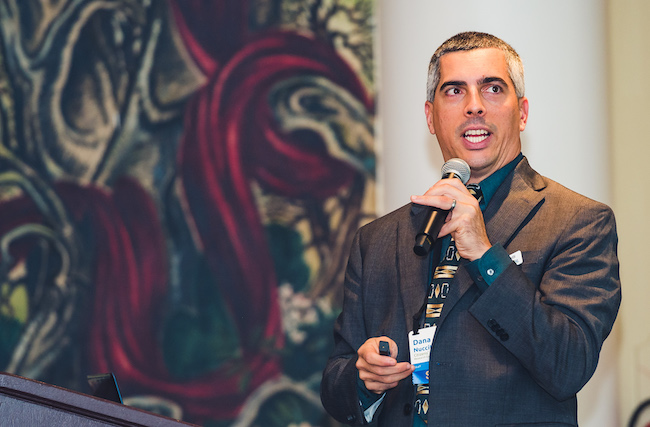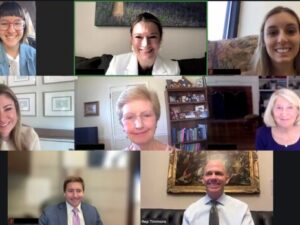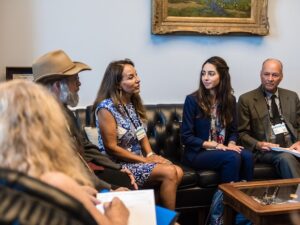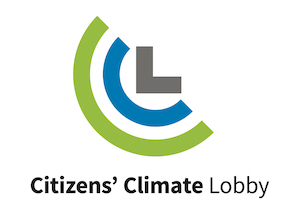
CCL Research Coordinator Dana Nuccitelli
CCL briefs House Climate Solutions Caucus on clean energy permitting reform
When the House Climate Solutions Caucus relaunched this summer, CCL said, “We are hoping to see — and our grassroots volunteers will be lobbying for — meaningful bipartisan climate legislation” to emerge from the group.
In recent weeks, we’ve seen the caucus take some encouraging steps in that direction. The Climate Solutions Caucus staffers called their first meeting of this Congress, and they devoted it to a briefing on the subject of clean energy permitting reform. Not only that, but they invited CCL staff to deliver that briefing.
Many congressional offices are not yet immersed in the nitty gritty details of this policy area, so the briefing was intended to help offices better understand the topic and the potential for a bipartisan clean energy permitting reform package.
This is a testament to the leadership role CCL has played in conveying the importance of clean energy permitting reform as a key climate solution, through citizen lobby meetings in June and ongoing outreach to Congress about the topic.
A peek into the briefing
On Thursday, Sept. 28, CCL’s Vice President of Government Affairs Ben Pendergrass, Senior Director of Government Affairs Jenn Tyler, and Research Coordinator Dana Nuccitelli delivered the briefing along with the Bipartisan Policy Center’s Director of Energy Policy and Carbon Management Xan Fishman. Ben discussed the history of the Climate Solutions Caucus, including CCL’s role in its formation in 2016.
Dana then delivered a 15-minute briefing that included a discussion of the main goals to be achieved through clean energy permitting reform, individual provisions that could advance those goals, and some bills and proposals that have included those provisions.
Though the caucus briefing itself was closed to the public and to the press, Ben and Dana recreated their remarks so the rest of us could hear what they presented to the caucus staffers. Watch it here, or read on for a recap:
Electrical transmission permitting reform is key to energy security
As Dana discussed, electrical transmission lines are a key climate solution. They allow us to connect more clean affordable electricity to the grid while improving energy security and avoiding power blackouts. That’s especially important in an age when climate change is bringing more extreme weather events that are increasingly straining our existing grid infrastructure. But the permitting process for big, important interstate transmission projects often takes well over a decade, bogged down by an avalanche of paperwork and bureaucracy that comes with applying for permits in every state and locality that the line will traverse.
Some solutions include requiring that regions be able to import a certain amount of electricity from neighboring regions, as the BIG WIRES Act would do, and handling the permitting of some big interstate transmission lines the way we do interstate natural gas pipeline permits. Those are handled by the Federal Energy Regulatory Commission (FERC) as a one-stop shop that consults with the individual states and localities that the project would traverse. This streamlines the process by reducing the red tape, paperwork, and bureaucracy involved.
Improving early community involvement and reducing lawsuits
Next, Dana talked about the importance of early community involvement. Communities should be able to provide their input on energy infrastructure projects that will directly affect them. Improving that early community involvement also reduces the risks of lawsuits brought by groups that feel excluded from the permit decision-making process; lawsuits that can extend project timelines for many years as they make their way through the legal system. Dana outlined a number of proposals to improve early community involvement, including establishing Chief Community Engagement Officers at federal agencies and allowing them to require Community Benefits Agreements between project developers and local residents.
The statute of limitations for National Environmental Protection Act (NEPA) lawsuits could also be shortened in a permitting reform package. As it now stands, anyone can bring a lawsuit as long as 6 years after a NEPA permit has been approved, which creates a lot of uncertainty for project developers. Various proposals have suggested shortening that timeline to anywhere between 2 months and 3 years.
Other potential permitting reforms
Dana outlined a few other components that could be included in a clean energy permitting reform package. For example, an existing process called FAST-41 that provides expedited permitting for big important energy infrastructure projects could be expanded. Federal agencies could designate go-to areas of low environmental and other impacts where energy infrastructure projects could be built with an expedited permitting process. Geothermal drilling could be granted the same permitting exclusions that oil and gas drilling already enjoys. And given the large increase of critical minerals that will be needed to build clean energy infrastructure, steps could be taken to improve the domestic minerals mining permitting process.
Let’s make a deal
Ultimately there’s a bipartisan clean energy permitting reform deal to be had that will improve grid security and energy affordability, streamline the permitting process, and help curb climate change. CCL appreciates the opportunity to brief the Climate Solutions Caucus on the subject, and that the caucus recognizes the importance and opportunity of clean energy permitting reform.
Want to help? Make sure your members of Congress have heard from you on this issue. Use our Click to Call tool to tell your representative to support clean energy permitting reform. Let’s make it happen!





